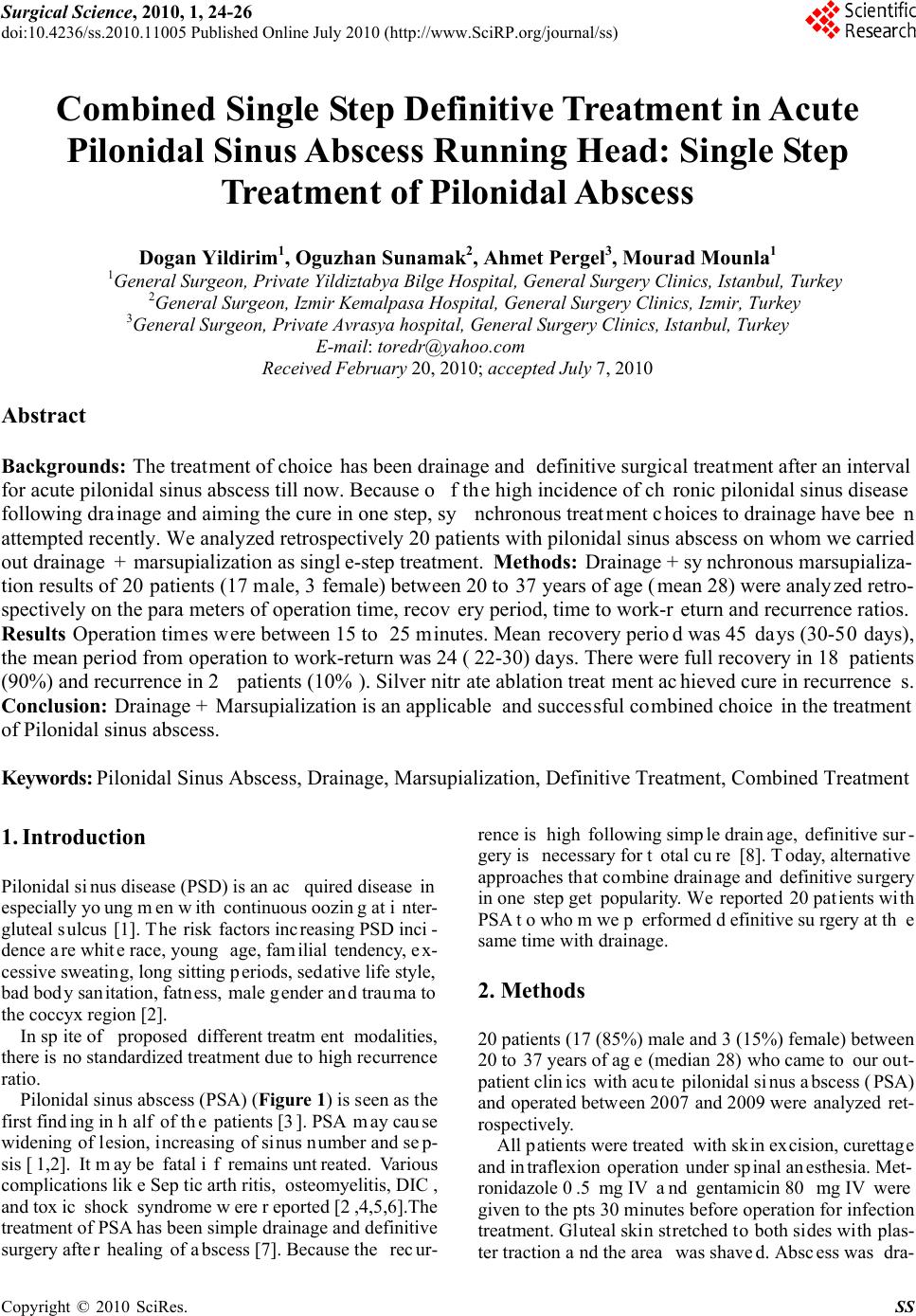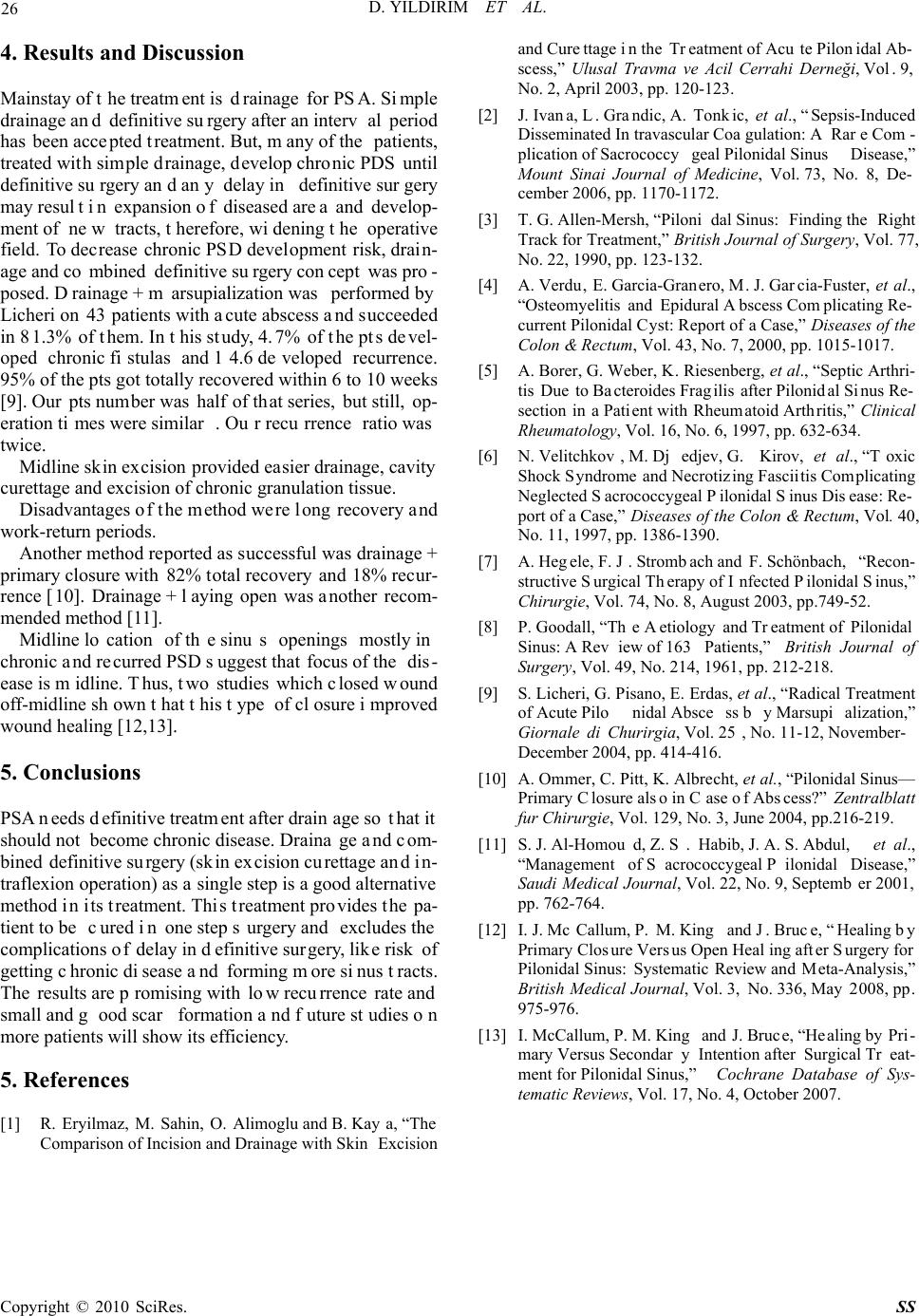Paper Menu >>
Journal Menu >>
 Surgical Science, 2010, 1, 24-26 doi:10.4236/ss.2010.11005 Published Online July 2010 (http://www.SciRP.org/journal/ss) Copyright © 2010 SciRes. SS Combined Single Step Definitive Treatment in Acute Pilonidal Sinus Abscess Running Head: Single Step Treatment of Pilonidal Abscess Dogan Yildirim1, Oguzhan Sunamak2, Ahmet Pergel3, Mourad Mounla1 1General Surgeon, Private Yildiztabya Bilge Hospital, General Surgery Clinics, Istanbul, Turkey 2General Surgeon, Izmir Kemalpasa Hospital, General Surgery Clinics, Izmir, Turkey 3General Surgeon, Private Avrasya hospital, General Surgery Clinics, Istanbul, Turkey E-mail: toredr@yahoo.com Received February 20, 2010; accepted July 7, 2010 Abstract Backgrounds: The treatment of choice has been drainage and definitive surgical treatment after an interval for acute pilonidal sinus abscess till now. Because of the high incidence of chronic pilonidal sinus disease following drainage and aiming the cure in one step, synchronous treatment choices to drainage have been attempted recently. We analyzed retrospectively 20 patients with pilonidal sinus abscess on whom we carried out drainage + marsupialization as single-step treatment. Methods: Drainage + synchronous marsupializa- tion results of 20 patients (17 male, 3 female) between 20 to 37 years of age (mean 28) were analyzed retro- spectively on the parameters of operation time, recov ery period, time to work-r eturn and recurrence ratios. Results Operation times were between 15 to 25 minutes. Mean recovery period was 45 days (30-50 days), the mean period from operation to work-return was 24 (22-30) days. There were full recovery in 18 patients (90%) and recurrence in 2 patients (10%). Silver nitrate ablation treatment achieved cure in recurrences. Conclusion: Drainage + Marsupialization is an applicable and successful combined choice in the treatment of Pilonidal sinus abscess. Keywords: Pilonidal Sinus Abscess, Drainage, Marsupialization, Definitive Treatment, Combined Treatment 1. Introduction Pilonidal sinus disease (PSD) is an acquired disease in especially young men with continuous oozing at inter- gluteal sulcus [1]. The risk factors increasing PSD inci- dence are white race, young age, familial tendency, ex- cessive sweating, long sitting periods, sedative life style, bad body sanitation, fatness, male gender and trauma to the coccyx region [2]. In spite of proposed different treatment modalities, there is no standardized treatment due to high recurrence ratio. Pilonidal sinus abscess (PSA) (Figure 1) is seen as the first finding in half of the patients [3]. PSA may cause widening of lesion, increasing of sinus number and sep- sis [1,2]. It may be fatal if remains untreated. Various complications like Septic arthritis, osteomyelitis, DIC, and toxic shock syndrome were reported [2,4,5,6].The treatment of PSA has been simple drainage and definitive surgery after healing of abscess [7]. Because the recur- rence is high following simple drainage, definitive sur- gery is necessary for total cure [8]. Today, alternative approaches that combine drainage and definitive surgery in one step get popularity. We reported 20 patients with PSA to whom we performed definitive surgery at th e same time with drainage. 2. Methods 20 patients (17 (85%) male and 3 (15%) female) between 20 to 37 years of age (median 28) who came to our out- patient clinics with acute pilonidal sinus abscess (PSA) and operated between 2007 and 2009 were analyzed ret- rospectively. All patients were treated with skin excision, curettage and intraflexion operation under spinal anesthesia. Met- ronidazole 0.5 mg IV and gentamicin 80 mg IV were given to the pts 30 minutes before operation for infection treatment. Gluteal skin stretched to both sides with plas- ter traction and the area was shaved. Abscess was dra-  D. YILDIRIM ET AL. 25 ined at midline where it gave fluctuation and the skin around the area was removed by a vertical rhomboid excision paralleling the intergluteal sulcus (Figure 2). The abscess pouch was washed out with physiologic saline and 10% povidine iodine solutions. The wall of cavity was curetted and chronic granulation tissue was excised (Figure 3). Healthy skin was fixed to the sacral fascia with 2/0 polypropylene single stitch at superior, inferior and both lateral sides (marsupialization) (Figure 4). The mean operation time was between 15 to 25 min- utes. Pts were given po ampicillin 375 mg three times a day for 5 days and discharged at post operative 2nd day. Serum physiologic dressing of the wound was made on every 2 days for first 10 post operative days and on every 3 day-interval after then until total wound healing oc- curred. Pts were advised to take shower before every dressing. Stitches were removed on 15th day and periodi- cal controls were made at 1st 2nd 3rd 6th and 12th months (Figure 5). 3. Findings Abscess pouch was running toward to the right gluteal region in 13 (65%), to the left in 5 (25%) and to the su- perior in 2 (2%) of pts. Mean recovery period was 45 Figure 1: Pilonidal sinus abscess. Figure 2. Line of excision. Figure 3. Cavity after curettage and washing. Figure 4. Marsupialization. Figure 5. Healing scar at the 6th month. days (between 30 to 50 days); the mean work-return pe- riod was 24 days (22-30). 18 (90%) of pts shown total recovery though 2 pts (10%) developed chronic pilonidal sinus disease on midline. These 2 pts were treated with silver nitrate 20% solution ablation and recovered well. There was no recurrence in follow up period. Copyright © 2010 SciRes. SS  D. YILDIRIM ET AL. Copyright © 2010 SciRes. SS 26 4. Results and Discussion Mainstay of the treatment is drainage for PSA. Simple drainage and definitive surgery after an interval period has been accepted treatment. But, many of the patients, treated with simple drainage, develop chronic PDS until definitive surgery and any delay in definitive surgery may result in expansion of diseased area and develop- ment of new tracts, therefore, widening the operative field. To decrease chronic PSD development risk, drain- age and combined definitive surgery concept was pro- posed. Drainage + marsupialization was performed by Licheri on 43 patients with acute abscess and succeeded in 81.3% of them. In this study, 4.7% of the pts devel- oped chronic fistulas and 14.6 developed recurrence. 95% of the pts got totally recovered within 6 to 10 weeks [9]. Our pts number was half of that series, but still, op- eration times were similar. Our recurrence ratio was twice. Midline skin excision provided easier drainage, cavity curettage and excision of chronic granulation tissue. Disadvantages of the method were long recovery and work-return periods. Another method reported as successful was drainage + primary closure with 82% total recovery and 18% recur- rence [10]. Drainage + laying open was another recom- mended method [11]. Midline location of the sinus openings mostly in chronic and recurred PSD suggest that focus of the dis- ease is midline. Thus, two studies which closed wound off-midline shown that this type of closure improved wound healing [12,13]. 5. Conclusions PSA needs definitive treatment after drainage so that it should not become chronic disease. Draina ge and com- bined definitive surgery (skin excision curettage and in- traflexion operation) as a single step is a good alternative method in its treatment. This treatment provides the pa- tient to be cured in one step surgery and excludes the complications of delay in definitive surgery, like risk of getting chronic disease and forming more sinus tracts. The results are promising with low recurrence rate and small and g ood scar formation and future studies on more patients will show its efficiency. 5. References [1] R. Eryilmaz, M. Sahin, O. Alimoglu and B. Kay a, “The Comparison of Incision and Drainage with Skin Excision and Curettage in the Treatment of Acute Pilonidal Ab- scess,” Ulusal Travma ve Acil Cerrahi Derneği, Vol. 9, No. 2, April 2003, pp. 120-123. [2] J. Ivana, L. Grandic, A. Tonkic, et al., “Sepsis-Induced Disseminated Intravascular Coagulation: A Rare Com- plication of Sacrococcygeal Pilonidal Sinus Disease,” Mount Sinai Journal of Medicine, Vol. 73, No. 8, De- cember 2006, pp. 1170-1172. [3] T. G. Allen-Mersh, “Pilonidal Sinus: Finding the Right Track for Treatment,” British Journal of Surgery, Vol. 77, No. 22, 1990, pp. 123-132. [4] A. Verdu, E. Garcia-Granero, M. J. Garcia-Fuster, et al., “Osteomyelitis and Epidural Abscess Complicating Re- current Pilonidal Cyst: Report of a Case,” Diseases of the Colon & Rectum, Vol. 43, No. 7, 2000, pp. 1015-1017. [5] A. Borer, G. Weber, K. Riesenberg, et al., “Septic Arthri- tis Due to Bacteroides Fragilis after Pilonidal Sinus Re- section in a Patient with Rheumatoid Arthritis,” Clinical Rheumatology, Vol. 16, No. 6, 1997, pp. 632-634. [6] N. Velitchkov, M. Djedjev, G. Kirov, et al., “Toxic Shock Syndrome and Necrotizing Fasciitis Complicating Neglected Sacrococcygeal Pilonidal Sinus Disease: Re- port of a Case,” Diseases of the Colon & Rectum, Vol. 40, No. 11, 1997, pp. 1386-1390. [7] A. Hegele, F. J. Strombach and F. Schönbach, “Recon- structive Surgical Therapy of Infected Pilonidal Sinus,” Chirurgie, Vol. 74, No. 8, August 2003, pp.749-52. [8] P. Goodall, “The Aetiology and Treatment of Pilonidal Sinus: A Review of 163 Patients,” British Journal of Surgery, Vol. 49, No. 214, 1961, pp. 212-218. [9] S. Licheri, G. Pisano, E. Erdas, et al., “Radical Treatment of Acute Pilonidal Abscess by Marsupialization,” Giornale di Churirgia, Vol. 25, No. 11-12, November- December 2004, pp. 414-416. [10] A. Ommer, C. Pitt, K. Albrecht, et al., “Pilonidal Sinus— Primary Closure also in Case of Abscess?” Zentralblatt fur Chirurgie, Vol. 129, No. 3, June 2004, pp.216-219. [11] S. J. Al-Homoud, Z. S. Habib, J. A. S. Abdul, et al., “Management of Sacrococcygeal Pilonidal Disease,” Saudi Medical Journal, Vol. 22, No. 9, September 2001, pp. 762-764. [12] I. J. McCallum, P. M. King and J. Bruce, “Healing by Primary Closure Versus Open Healing after Surgery for Pilonidal Sinus: Systematic Review and Meta-Analysis,” British Medical Journal, Vol. 3, No. 336, May 2008, pp. 975-976. [13] I. McCallum, P. M. King and J. Bruce, “Healing by Pri- mary Versus Secondar y Intention after Surgical Tr eat- ment for Pilonidal Sinus,” Cochrane Database of Sys- tematic Reviews, Vol. 17, No. 4, October 2007. |

